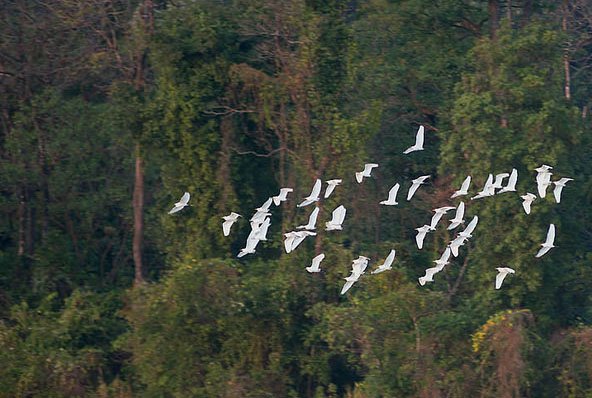Birding In Namdhapa Wildlife Sanctuary
The Namdhapa Wildlife Sanctuary is home to about 400 species of Birds. Some of the Birds that can be sighted here are so rare that they cannot be found elsewhere in the country. The White Winged Wood Duck is seldom to be seen at a different place. At the Noa-Dihing River, wading Birds like the Rufus necked Hornbills, Ibis bills and the White-bellied Herons crowd in large numbers.
It is indeed a very enthralling experience not just for the ornithologists but for any visitor to see the variety and diversity of Birds that Namdhapa is home to. Some of the exotic Birds that you can witness in Namdhapa include Satyr Tragopans, Kalij and Monal Pheasants, Blue-napped Pittas, Snowy-throated babblers, Jungle fowls, Forest Eagle Owl, Cochoas, Ward’s Trogons and Beautiful Nuthatches.
Bird Watching in Namdhapa is indeed a delightful activity. As the forests are unexplored and unaffected by the vagaries of modern civilization it is possible to see the Birds in their natural surroundings in Namdhapa. Sometimes the sweet humming voices of these colorful feathered creatures and at other times even their cacophony as they vie for space reaches the ears of the bird watchers and enthralls them. Derive all possible pleasure from the multifarious sights and sounds of the Birds in Namdhapa.
Highlights:
• Trek through a mix of Assam valley Tropical Rain forest and North Indian Tropical Moist Deciduous forest.
• The only place in the world where you can find 4 big cats in one area.
• Birding paradise with more than 400 species represented with some only found in this area in India.
• Trek through beautiful pine and rhododendron forests in Eastern Himalayas
Things to keep in mind before traveling
- Every tourist visiting Arunachal Pradesh needs to obtain an Inner Line Permit and a Protected Area Permit which can be collected from Delhi, Kolkata, Guwahati or Tezpur airports.
- Leeches are everywhere in Namdapha and in large numbers. Carry protective gear.
- To really get the most out of a Namdapha visit, camping inside the Park at Hornbill, Bulbulia, Haldibari is a must.
- Rain is never predictable, give yourself some extra days to make sure that a trip is not wasted.
- Locals are friendly and helpful. Be patient as not everyone will know fluent Hindi or English.
- Most cell phone networks don’t work well, so inform your family or friends about your whereabouts whenever possible.
- Don’t forget to carry some ready to cook food packets or instant noodles if you’re strictly a vegetarian.
- Carry extra batteries, power banks and most importantly warm clothing.
- Keep at least a couple of extra days in hand in case of any problems like landslides and bad weather on your way.
Dibrugarh airport and Tinsukia rail station are the nearest points. Assam State Transport Corporation and Arunachal Pradesh State Transport buses ply daily from Dibrugarh to Miao. Miao is the entry point for Namdapha. The distance between Dibrugarh and Miao is 160 km and is best covered by hired cars. A further drive of 26 kms is required to reach Deban, a tiny hamlet at the foot of the Patkai range of hills on the banks of the Noa-Dihing. The Deban Forest Guest House is the popular base for birding Namdapha.
Mid-September To April Is The Best Time To Take This Trek
Day 1: Delhi/ Dibrugarh: Arrive afternoon at Dibrugarh airport, assistance by Aborcountry member, transfer to beautiful Colonial Tea Garden Bungalow turned into a Heritage Cottage. Overnight Tea Bungalow.
Day 2: Dibrugarh/ Miao/ Namdhapha: Morning after English breakfast drive 5hrs to Miao, the Sub-divisional headquarter of Changlang Dist. And the gateway of Namdhapha National Park and Tiger Reserve, continue drive inside the park 25 kms to Deban the last driving point. Overnight Forest bungalow or Tent
Day 3: Namdhapha in and around: Whole day bird around Deban area beside Noa-Dihing River. Overnight Forest bungalow or Tent.
Day 4: Namdhapha/ Haldibari: Morning after breakfast trek and bird (6kms) to Haldibari, cross the Noa-Dihing river on boat. Pack lunch on the way. We will camp at Haldibari. Overnight Tent
Day 5: Haldibari/ Hornbill: Morning trek to Hornbill (5 kms) bird around on the way, lunch on the way. Overnight Tent.
Day 6: Hornbill/ in & around: Today bird around Hornbill and stay the night at Hornbill in Tent.
Day 7: Hornbill/ Bulbulia: Today we will trek to Bulbulia (3kms) and stay the night in Tent.
Day 8: Bulbulia/ Haldibari: Trek back to Haldibari (8 kms). Overnight Tent.
Day 9: Haldibari/ Deban: Trek back to Deban, cross the Noa-Dihing river. Overnight Forest bungalow or tent.
Day 10: Deban/ Digboi: Morning drive to Digboi Oil Refinery in Assam. Digboi Oil Refinery is the first Oil field of India, visit the Oil Museum, World War-II cemetery of the allied forces. Overnight Digboi Oil Field Bungalows or Tourist Lodge.
Day 11: Digboi/ Kaziranga: Morning drive to Kaziranga National Park and Project Tiger. Home of Great Indian One horn Rhinoceros. Enroute visit the historical city and the capital of Ahom Kingdom who ruled the Brahmaputra valley for over Six hundred years. Overnight Wild Grass Resort.
Day12: Kaziranga: Early morning drive to to the Park for Elephant Safari to have closer encounter with Rhino, drive back to resort for breakfast. Whole day jeep safari inside the park. Overnight Wild Grass Resort.
Day 13: Kaziranga: Birding at Kaziranga National Park. Overnight Wild Grass Resort.
Day 14: Kaziranga/ Nameri National Park: Drive to Nameri National Park & Project Tiger. On arrival check-into Camp. Afternoon cross the Jia Bhorali River to enter into the Park, Trek around and back to Camp later. Overnight Nameri Eco Camp
Day 15: Nameri National Park: Early morning walk around the Camp, later after breakfast raft down the river for. Afternoon back to camp later bird inside the park. Overnight Eco Camp.
Day 16: Nameri/ Guwahati: Early morning drive to Guwahati airport, on arrival check-in for flight to onward destination.





